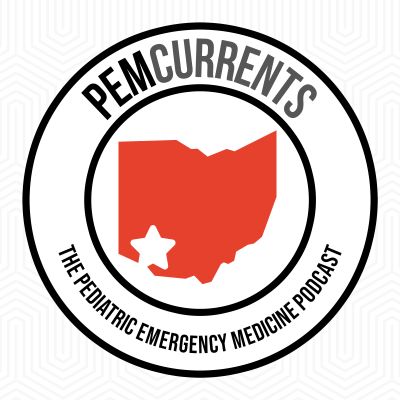PEM Currents: The Pediatric Emergency Medicine Podcast is an evidence-based podcast focused on the care of ill and injured children in the Emergency Department. The host is Brad Sobolewski, author of PEMBlog.com and a Professor of Pediatric Emergency Medicine at Cincinnati Children's and the University of Cincinnati.
https://www.pemcincinnati.com/podcasts/?page_id=6
Do we need labs or a head CT after simple febrile or unprovoked seizures?
Labs or CT scans are not necessary to provide additional diagnostic information or reassurance for most children who recover completely following simple febrile seizures or unprovoked first time generalized seizures. The rate of abnormalities on these studies is very low, and the cost and downsides are too high to justify ordering them on a regular basis.
This podcast episode is designed to disseminate the important work of Choosing Wisely, an initiative of the the American Board of Internal Medicine Foundation, the goal of which is the spark conversations between clinicians and patients about what tests, treatments, and procedures are needed – and which ones are not.
The Choosing Wisely recommendation: Do not order laboratory testing or a CT scan of the head for a patient with an unprovoked, generalized seizure or a simple febrile seizure who has returned to baseline mental status
The Choosing Wisely Pediatric Emergency Medicine Recommendations
The Choosing Wisely Campaign Toolkit
PEMBlog
@PEMTweets on… sigh “X” (Twitter)
My Instagram
My Mastodon account @bradsobo
ReferencesAmerican Academy of Pediatrics, Subcommittee on Febrile Seizures. Neurodiagnostic evaluation of the children with a simple febrile seizure. Pediatrics. 2011;127(2):389-394. DOI: https://doi.org/10.1542/peds.2010-3318
Brugman J, Solomons RS, Lombard C, Redfern A, Du Plessis AM. Risk-Stratification of Children Presenting to Ambulatory Paediatrics with First-Onset Seizures: Should We Order an Urgent CT Brain?. J Trop Pediatr. 2020;66(3):299-314. doi:10.1093/tropej/fmz071
Expert Panel on Pediatric Imaging, Trofimova A, Milla SS, et al. ACR Appropriateness Criteria® Seizures-Child. J Am Coll Radiol. 2021;18(5S):S199-S211. doi:10.1016/j.jacr.2021.02.020
Fine A, Wirrell EC. Seizures in Children. Pediatr Rev. 2020;41(7):321-347. doi:10.1542/pir.2019-0134
Hirtz D, Ashwal S, Berg A, et al. Practice parameter: Evaluating a first nonfebrile seizure in children. Report of the Quality Standards Subcommittee of the American Academy of Neurology, the Child Neurology Society, and the American Epilepsy Society. Neurology. 2000; 55(5):616-623. Reaffirmed October 17, 2020
Jaffe M, Bar-Joseph G, Tirosh E. Fever and convulsions: indications for laboratory investigations. Pediatrics. 1981;67(5):729 –731
Maytal J, Krauss JM, Novak G, Nagelberg J, Patel M. The role of brain computed tomography in evaluating children with new onset of seizures in the emergency department. Epilepsia. 2000;41(8):950-954. doi:10.1111/j.1528-1157.2000.tb00277.x
McKenzie KC, Hahn CD, Friedman JN; Canadian Paediatric Society, Acute Care Committee. Emergency management of the paediatric patient with convulsive status epilepticus. Paediatr Child Health. 2021;26(1):50-57
NICE. Epilepsies in children, young people and adults; Evidence reviews underpinning recommendations. NICE guideline NG217. 2022. Accessed online at https://www.nice.org.uk/guidance/ng217/evidence/b-computed-tomography-scan-performance-in-people-with-epilepsy-pdf-398366282811
NICE. Epilepsies in children, young people and adults. NICE guideline NG217. 2022. Accessed online at https://www.nice.org.uk/guidance/ng217
Reinus WR, Wippold FJ, 2nd, Erickson KK. Seizure patient selection for emergency computed tomography. Ann Emerg Med 1993;22:1298-303.
Riviello JJ Jr, Ashwal S, Hirtz D, et al; American Academy of Neurology Subcommittee; Practice Committee of the Child Neurology Society. Practice parameter: Diagnostic assessment of the child with status epilepticus (an evidence-based review): Report of the Quality Standards Subcommittee of the American Academy of Neurology and the Practice Committee of the Child Neurology Society. Neurology. 2006;67(9):1542-1550
Royal Children’s Hospital Melbourne. Afebrile Seizures. 2020. Accessed online at https://www.rch.org.au/clinicalguide/guideline_index/afebrile_seizures/
Sawires R, Buttery J, Fahey M. A Review of Febrile Seizures: Recent Advances in Understanding of Febrile Seizure Pathophysiology and Commonly Implicated Viral Triggers. Front Pediatr. 2022;9:801321. Published 2022 Jan 13. doi:10.3389/fped.2021.801321
Shah SS, Alpern ER, Zwerling L, Reid JR, McGowan KL, Bell LM. Low Risk of Bacteremia in Children With Febrile Seizures. Arch Pediatr Adolesc Med. 2002;156(5):469–472. doi:10.1001/archpedi.156.5.469
Subcommittee on Febrile Seizures; American Academy of Pediatrics. Neurodiagnostic evaluation of the child with a simple febrile seizure. Pediatrics. 2011;127(2):389-394. doi:10.1542/peds.2010-3318
Veerapandiyan A, Aravindhan A, Takahashi JH, Segal D, Pecor K, Ming X. Use of Head Computed Tomography (CT) in the Pediatric Emergency Department in Evaluation of Children With New-Onset Afebrile Seizure. J Child Neurol. 2018;33(11):708-712. doi:10.1177/0883073818786086
Young AC, Costanzi JB, Mohr PD, Forbes WS. Is routine computerised axial tomography in epilepsy worth while?. Lancet. 1982;2(8313):1446-1447. doi:10.1016/s0140-6736(82)91340-x
Yousefichaijan P, Dorreh F, Abbasian L, Pakniyat AG. Assessing the prevalence distribution of abnormal laboratory tests in patients with simple febrile seizure. J Pediatr Neurosci. 2015;10(2):93-97. doi:10.4103/1817-1745.159180
